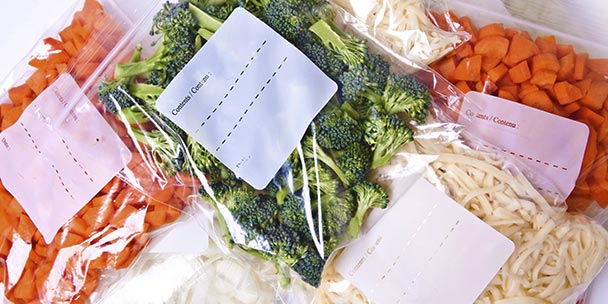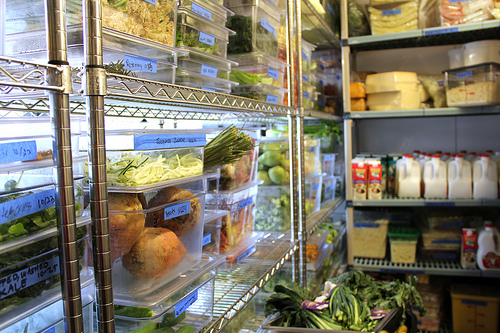Tips for Organizing Your Walk-in Cooler or Freezer
There are many ways you can organize your unit, so it’s important to take some time to plan how you’re going to make the best use of your space.
Here are some of the major benefits to implementing a thoughtful storage plan:
- Prolong the shelf-life and increase the quality of your food
- Quickly and easily take note of inventory and restock
- Avoid health code violations
- Decrease wasted and spoiled food items
- Decrease frequency of fridge problems and repairs
- Make cleanup easier and quicker
So what are some things you need to consider when it comes to organizing your walk-in cooler or freezer? Here are some tips:
Label everything

Many foods look similar, such as parsley and cilantro, and the last thing you want to do is mix up two ingredients and ruin your dish. Looks can also be deceiving when it comes to freshness. Plenty of items, for example, milk and eggs, can look fresh at a glance when they are in fact spoiled.
To accurately determine the freshness and quality of an ingredient, you need to know when it was received and its use-by date, and to accurately identify an item, you need to know its name. Always, always, always label everything that enters the fridge with the proper name and dates.
In addition to labeling individual items, you should also label the shelves. Doing this will make it easier to remember where to place items and quickly see if something needs restocking.
Implement a FIFO method
The First In First Out (FIFO) method is a widely used system for storing and organizing food to maximize freshness and quality. The principle is that the first thing to enter the fridge should be the first thing to leave.
Using FIFO, you increase the freshness of your food and decrease waste by making sure you use items before they spoil.
You can implement this method simply by making it a rule to place new items towards the back of the refrigerator, behind older items. That way it’s convenient to grab the item that was in the fridge longest, and you can easily continue the rotation by pushing older items forward.
Keep lowest rack 6 inches or more above ground
Keeping the lowest rack 6 inches or more above the ground promotes good sanitation and saves time on cleaning.
This extra space allows you to have ample room to mop up spills quickly and conveniently, so they don’t rot or attract pests. On top of that, keeping the shelves high above the ground makes it harder for pests to reach food.
Keep meat products on lowest rack
If raw or thawing meat is kept on high racks, marinate and liquid could potentially fall onto other foods and cause dangerous bacteria growth. Cross-contamination is a big health code violation and could end up costing you money and making your customers sick.
Keep meat on the lowest rack to prevent cross-contamination in case of a spill. Instead of falling onto another product, the liquid will fall onto the ground and not damage any food. That six inches of space you have between the shelf and the ground will allow you to easily mop up the spill and be on your way.
Keep delicate food away from fans

If you keep delicate produce, such as berries and leafy greens, close to fans they’re much more likely to spoil prematurely. Strong air flow in a fridge can damage these items and even cause freezer burn in a freezer.
Be sure to place delicate food items far from fans, and place only items that get used quickly near them.
Leave room for circulation
Your fridge or freezer needs to be able to circulate air between items in order to properly cool or freeze everything. Not leaving enough space between items can cause uneven cooling/freezing and hot spots, and can overwork your unit. This puts your food at risk of spoiling, and you at risk of losing money.
A good rule of thumb is to keep 3-6 inches of space between each item. This extra space keeps your unit running at its optimum cooling power, and allows for each item to be evenly cooled.
Final Thoughts
Now that you know these pointers, it’s time to apply them. Take some time to educate your employees on each of these tips and their benefits. Make sure that your employees know where the labels are located, how to gauge the right amount of space between each item, how to organize the items according to the FIFO method, etc. If you consistently enforce these suggestions, you’ll save money, time, and keep your fridge or freezer running at its best.
Have any questions about your walk-in cooler or freezer? We’re here to help! Call 512 Refrigeration Services for any of your Austin, Texas commercial refrigeration issues. Our expert technicians are available 24/7 to troubleshoot problems with your ice machine, reach-in cooler, walk-in cooler or freezer, and more.
Related posts

Finding the right location for your business is step one, but after you’ve settled on the perfect spot - you’ll need the equipment to match! Or, maybe you’ve been in the right spot for a while now and are looking for an upgrade (or “downgrade”) to some equipment that is more suitable for your operation. No matter what your situation, there’s a lot to keep in mind, most of which will be unique to you and your restaurant. In this post, we’ll fill you in on some of the more universal information. Making…

Is your commercial refrigerator not cooling properly? If your answer is yes, you’re not alone. This is one of the most commonly reported refrigeration issues out there. There are a number of possible reasons as to why your refrigerator's cooling power isn’t up to par; these range from simple do-it-yourself fixes, to requiring professional assistance to move your cooler or replace broken parts. Luckily, it’s often easy to troubleshoot the issue and determine the proper solution. Here are…

Commercial walk-in coolers and freezers are airtight, enclosed spaces, so it’s not unheard of for them to develop odors from time-to-time. But how much of that odor is normal? And when is a bad smell indicative of a larger problem with your equipment? Here are the best ways to manage odors in your commercial walk-in coolers and freezers and how to recognize if you have an odor-related problem with your commercial refrigeration equipment that may require expert inspection or repair. Visual Inspection The…
